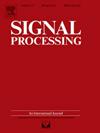一种基于流形的xml - mimo系统近场LoS通道码本设计方案
IF 3.4
2区 工程技术
Q2 ENGINEERING, ELECTRICAL & ELECTRONIC
引用次数: 0
摘要
在本文中,我们提出了一种基于流形的码本设计方案,用于用户配备多天线的超大规模多输入多输出(xml - mimo)系统中的近场视线(LoS)通道。考虑多接收天线的空间分布特点,建立了LoS XL-MIMO信道模型。该方案采用流形优化设计码本,与传统的极域码本相比,具有更高的可实现率。具体来说,为了建立码本,通过最小化不同用户位置的两个信道矩阵之间的不相干来量化空间中的角度和距离参数。由于近场LoS通道矩阵不再是1级,因此为每个量化点设计了多个码字来覆盖LoS路径。在此基础上,将BS端和用户端的码字联合设计表述为具有常模约束的优化问题,该优化问题定义为复圆流形形式的几何结构。为了解决常模优化问题,我们将其解耦为两个独立的子问题。采用复圆流形上的黎曼梯度下降算法有效地解决了这类问题。数值结果表明了该方案在提高可达率方面的优越性。本文章由计算机程序翻译,如有差异,请以英文原文为准。
A manifold-based codebook design scheme for near-field LoS channel in XL-MIMO systems
In this paper, we propose a manifold-based codebook design scheme for near-field line-of-sight (LoS) channel in extremely large-scale multiple-input–multiple output (XL-MIMO) systems, where the user is equipped with multiple antennas. The LoS XL-MIMO channel model has been developed, considering the spatial distribution characteristics of multiple receiving antennas. The proposed scheme employs manifold optimization to design the codebook, resulting in a higher achievable rate compared to the conventional polar-domain codebook. Specifically, to establish the codebook, the angle and distance parameters in space are quantified by minimizing the incoherence between two channel matrices of different user locations. Since the near-field LoS channel matrix is no longer rank one, multiple codewords are designed for each quantified point to cover the LoS paths. Furthermore, the joint design of codewords at the BS and user side is formulated as an optimization problem with a constant modulus constraint, which defines a geometric structure in the form of a complex circle manifold. To solve the constant modulus optimization problem, we decouple it into two independent sub-problems. The Riemannian gradient descent algorithm on the complex circle manifold is applied to efficiently solve such problems. Numerical results demonstrate the superiority of our proposed scheme in improving the achievable rate.
求助全文
通过发布文献求助,成功后即可免费获取论文全文。
去求助
来源期刊

Signal Processing
工程技术-工程:电子与电气
CiteScore
9.20
自引率
9.10%
发文量
309
审稿时长
41 days
期刊介绍:
Signal Processing incorporates all aspects of the theory and practice of signal processing. It features original research work, tutorial and review articles, and accounts of practical developments. It is intended for a rapid dissemination of knowledge and experience to engineers and scientists working in the research, development or practical application of signal processing.
Subject areas covered by the journal include: Signal Theory; Stochastic Processes; Detection and Estimation; Spectral Analysis; Filtering; Signal Processing Systems; Software Developments; Image Processing; Pattern Recognition; Optical Signal Processing; Digital Signal Processing; Multi-dimensional Signal Processing; Communication Signal Processing; Biomedical Signal Processing; Geophysical and Astrophysical Signal Processing; Earth Resources Signal Processing; Acoustic and Vibration Signal Processing; Data Processing; Remote Sensing; Signal Processing Technology; Radar Signal Processing; Sonar Signal Processing; Industrial Applications; New Applications.
 求助内容:
求助内容: 应助结果提醒方式:
应助结果提醒方式:


